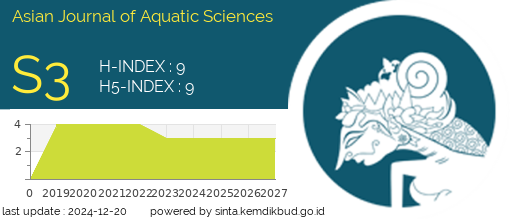MANAGING CANNIBALISM AND IMPROVING LARVAL SURVIVAL IN BARRAMUNDI HATCHERY
DOI:
https://doi.org/10.31258/ajoas.8.2.203-213Keywords:
Cannibalism, Hatchery Management, Tropical Aquaculture, Lates calcariferAbstract
Barramundi (Lates calcarifer) are economically valuable and usually cultivated in tropical marine hatcheries. Their fertilization and hatching rates are generally high, but poor survivorship of larvae due to cannibalism and cohort mismanagement remains a problem. In this study, we sought to address field-based techniques for controlling cannibalism and augmenting larval survival in large-scale hatcheries at Balai Besar Perikanan Budidaya Laut (BBPBL), Lampung, Indonesia. A 30-day rearing cycle was completed through descriptive observation methods focused on reproduction, and growth monitoring was performed concerning feeder grade improvement. The recorded data indicated a fertilization rate of 86% alongside an impressive hatching rate of 96%. However, the survival rate dropped to 52%, primarily due to cannibalism. Considerable size disparity among cohorts, lack of grading during asynchronous growth periods, and stunted development seem to drive cannibalism under these conditions. Increasing the frequency or decreasing the size gap between assessments has proven effective in enhancing survival levels alongside better feeding synchronization, water quality management, and reduced particulate matter concentration in water tanks. These outcomes will assist tropical aquaculture systems with long-term sustainable frameworks while providing actionable insight to hatchery managers without further testing
Downloads
References
1. Ribeiro, F.F., & Qin, J.G. Modelling Size-Dependent Cannibalism in Barramundi Lates calcarifer: Cannibalistic Polyphenism and its Implications to Aquaculture. PLOS ONE, 2013; 8(12): e82488
2. Safiin, N.S.Z., Ching, F.F., & Shapawi, R. Successful Co-Feeding of Asian Seabass, Lates calcarifer Larvae, with Palm Oil-Based Microdiets and Live Feeds. Frontiers in Sustainable Food Systems, 2022; 6: 836275
3. Vo, B.V., Siddik, M.A.B., Chaklader, M.R., Fotedar, R., Nahar, A., Foysal, M.J., Foysal, M.J., Bui, D.P., & Nguyen, H.Q. Growth and Health of Juvenile Barramundi (Lates calcarifer) Challenged with DO Hypoxia after Feeding Various Inclusions of Germinated, Fermented, and Untreated Peanut Meals. PLOS ONE, 2020;15(4):e0232278
4. Siddik, M.A.B., Siddik, M.A.B., Howieson, J., Ilham, I., & Fotedar, R. Growth, Biochemical Response, and Liver Health of Juvenile Barramundi (Lates calcarifer) Fed Fermented and Non-Fermented Tuna Hydrolysate as Fishmeal Protein Replacement Ingredients. PeerJ., 2018; 6:e4870
5. Yazid, S.H.M., Daud, H.M., Azmai, M.N.A., Mohamad, N., & Nor, N.M. Estimating the Economic Loss Due to Vibriosis in Net-Cage Cultured Asian Seabass (Lates calcarifer): Evidence From the East Coast of Peninsular Malaysia. Frontiers in Veterinary Science, 2021; 8: 644009
6. Salini, M.J., Turchini, G.M., Wade, N.M., & Glencross, B.D. Rapid Effects of Essential Fatty Acid Deficiency on Growth and Development Parameters and Transcription of Key Fatty Acid Metabolism Genes in Juvenile Barramundi (Lates calcarifer). British Journal of Nutrition, 2015; 114(11): 1784-1796
7. Sumaila, U.R., Pierruci, A., Oyinlola, M.A., Cannas, R., Froese, R., Glaser, S., ... & Pauly, D. Aquaculture Over-Optimism? Frontiers in Marine Science, 2022; 9: 984354.
8. Garrido, S., Ben-Hamadou, R., Santos, A.M.P., Ferreira, S., Teodósio, M.A., Cotano, U., Irigoien, X., Peck, M.A., Saiz, E., & Ré, P. Born Small, Die Young: Intrinsic, Size-Selective Mortality in Marine Larval Fish. Scientific Reports, 2015; 5: 17065
9. Hamre, K., Yúfera, M., Rønnestad, I., Boglione, C., Conceição, L.E.C., & Izquierdo, M. Fish Larval Nutrition and Feed Formulation - Knowledge Gaps and Bottlenecks for Advances in Larval Rearing. Reviews in Aquaculture, 2013; 5(1): 26-58
10. Vadstein, O., Attramadal, K.J.K., Bakke, I., Forberg, T., Olsen, Y., Verdegem, M.C.J., Giatsis, C., Skjermo, J., Aasen, I.M., Gatesoupe, F.-J., Dierckens, K., Sorgeloos, P., & Bossier, P. Managing the Microbial Community of Marine Fish Larvae: A Holistic Perspective for Larviculture. Frontiers in Microbiology, 2018; 9:1820
11. Rønnestad, I., Yúfera, M., Ueberschär, B., Ribeiro, L., Sæle, Ø., & Boglione, C. Feeding Behaviour and Digestive Physiology in Larval Fish: Current Knowledge, and Gaps and Bottlenecks in Research. Reviews in Aquaculture, 2013; 5(1): 59-98
12. Kawano, S.M. Fish Larvae Feed in the Danger Zone. Journal of Experimental Biology, 2017; 220(15): 2683
13. Robert, D., Shoji, J., Sirois, P., Takasuka, A., Catalán, I. A., Folkvord, A., Ludsin, S.A., Peck, M.A., Sponaugle, S., Ayón, P., Brodeur, R.D., D’Alessandro, E.K., Dower, J.F., Fortier, L., García, A., Huebert, K.B., Hufnagl, M., Ito, S., Joh, M., … Pepin, P. Life in the Fast Lane: Revisiting the Fast Growth High Survival Paradigm during the Early Life Stages of Fishes. Fish and Fisheries, 2023; 24(5): 863-888
14. Naumowicz, K., Pajdak, J., Terech-Majewska, E., & Szarek, J. Intracohort Cannibalism and Methods for its Mitigation in Cultured Freshwater Fish. Reviews in Fish Biology and Fisheries, 2017; 27: 193-208
15. Saraiva, J., Rachinas-Lopes, P., & Arechavala-Lopez, P. Finding the "Golden Stocking Density": A Balance between Fish Welfare and Farmers' Perspectives. Frontiers in Veterinary Science, 2022; 9: 930221.
16. Swain, H.S., Das, B.K., Upadhyay, A., Ramteke, M.H., Kumar, V., Meena, D.K., Sarkar, U.K., Chadha, N.K., & Rawat, K. Stocking Density-Mediated Stress Modulates Growth Attributes in Cage-Reared Labeo rohita (Hamilton) using Multifarious Biomarker Approach. Dental Science Reports, 2022; 12(1): 9869
17. Trisnasari, V., Subandiyono, S., & Hastuti, S. Pengaruh Triptofan dalam Pakan Buatan terhadap Tingkat Kanibalisme dan Pertumbuhan Lobster Air Tawar (Cherax quadricarinatus). Indonesia Journal of Tropical Aquaculture, 2020; 4(1): 19-30
18. Burgess, A.I., Callan, C.K., Touse, R., & Santos, M.D. Increasing Survival and Growth in Larval Leopard Coral Grouper (Plectropomus leopardus) using Intensively Cultured Parvocalanus crassirostris nauplii. Journal of The World Aquaculture Society, 2020; 51(1): 171-182
19. Olsson, K.H., Olsson, K.H., & Andersen, K.H. Cannibalism as a Selective Force on Offspring Size in Fish. Oikos, 2018; 127(9): 1264-1271
20. Persson, L., Roos, A.M. de, Claessen, D., Byström, P., Lövgren, J., Sjögren, S., Svanbäck, R., Wahlström, E., & Westman, E. (2003). Gigantic Cannibals are Driving a Whole-Lake Trophic Cascade. Proceedings of the National Academy of Sciences of the United States of America, 2003; 100(7): 4035-4039
21. Ohlberger, J., Langangen, Ø., Stenseth, N. Chr., & Vøllestad, L.A. Community-Level Consequences of Cannibalism. The American Naturalist, 2012; 180(6)
22. Allen, B.G.V., Dillemuth, F.P., Flick, A.J., Faldyn, M.J., Clark, D.R., Rudolf, V.H.W., & Elderd, B.D. Cannibalism and Infectious Disease: Friends or Foes? The American Naturalist, 2017; 190(3): 299-312
23. Reglero, P., Urtizberea, A., Torres, A.P., Alemany, F., & Fiksen, Ÿ. Cannibalism among Size Classes of Larvae May be a Substantial Mortality Component in Tuna. Marine Ecology Progress Series, 2011; 433: 205-219
24. Mair, G.C., Halwart, M., Derun, Y., & Costa-Pierce, B.A. A Decadal Outlook for Global Aquaculture. Journal of The World Aquaculture Society, 2023; 54(2): 196-205
25. Uriarte, I., Astorga, M., Navarro, J.C., Viana, M. T., Rosas, C., Molinet, C., Hernández, J., Navarro, J.M., Moreno-Villoslada, I., Amthauer, R., Kausel, G., Figueroa, J., Paredes, E., Paschke, K., Romero, A., Hontoria, F., Varó, I., Vargas-Chacoff, L., Toro, J.E., … Farías, A. Early Life Stage Bottlenecks of Carnivorous Mollusks under Captivity: a Challenge for their Farming and Contribution to Seafood Production. Reviews in Aquaculture, 2019; 11(3): 431-457
26. Rice, J.A., Miller, T.J., Rose, K.A., Crowder, L.B., Marschall, E.A., Trebitz, A.S., & DeAngelis, D.L. Growth Rate Variation and Larval Survival: Inferences from an Individual-Based Size-Dependent Predation Model. Canadian Journal of Fisheries and Aquatic Sciences, 1993; 50(1): 133-142
27. Marra, P.P., Cohen, E.B., Loss, S.R., Rutter, J.E., & Tonra, C.M. A Call for full Annual Cycle Research in Animal Ecology. Biology Letters, 2015; 11(8)
28. Chan, K.Y.K., Sewell, M.A., & Byrne, M. Revisiting the Larval Dispersal Black Box in the Anthropocene. Ices Journal of Marine Science, 2018; 75(6): 1841-1848
29. Morgan, S.G., & Fisher, J.L. Larval Behavior Regulates Nearshore Retention and Offshore Migration in an Upwelling Shadow Along the Open Coast. Marine Ecology Progress Series, 2010; 404: 109-126
30. Berenshtein, I., Faillettaz, R., Irisson, J.-O., Kiflawi, M., Siebeck, U.E., Leis, J.M., & Paris, C.B. Evidence for a Consistent Use of External Cues by Marine Fish Larvae for Orientation. Communications Biology, 2022; 5(1): 1307
31. Fiksen, Ø., & Jorgensen, C. The Model of Optimal Behaviour in Fish Larvae Predicts that Food Availability Determines Survival but Not Growth. Marine Ecology Progress Series, 2011; 432: 207-219
32. Breaux, J.A., Schumacher, M.K., & Juliano, S.A. What does Not Kill Them Makes Them Stronger: Larval Environment and Infectious Dose Alter Mosquito Potential to Transmit Filarial Worms. Proceedings of The Royal Society B: Biological Sciences, 2014; 281(1786)
33. Mastrantonio, V., Crasta, G., Urbanelli, S., & Porretta, D. Cannibalism and Necrophagy Promote a Resource Loop and Benefit Larval Development in Insects of Temporary Waters. Insects, 2021; 12(7): 657
34. Evans, K.G., Neale, Z.R., Holly, B.A., Canizela, C., & Juliano, S.A. Survival-Larval Density Relationships in the Field and Their Implications for Control of Container-Dwelling Aedes Mosquitoes. Insects, 2022; 14(1): 17
35. MacKenzie, B.R., John, M. St., & Wieland, K. Eastern Baltic Cod : Perspectives from Existing Data on Processes Affecting Growth and Survival of Eggs and Larvae. Marine Ecology Progress Series, 1996; 134: 265-281
36. Peck, M.A., & Daewel, U. Physiologically based Limits to Food Consumption and Individual-Based Modeling of Foraging and Growth of Larval Fishes. Marine Ecology Progress Series, 2007; 347: 171-183
37. Wissinger, S.A., Whiteman, H.H., Denoël, M., Mumford, M.L., & Aubee, C.B. Consumptive and Nonconsumptive Effects of Cannibalism in Fluctuating Age-Structured Populations. Ecology, 2010; 91(2): 549-559
38. Basheer, A., Quansah, E., Bhowmick, S., & Parshad, R.D. Prey Cannibalism Alters the Dynamics of Holling–Tanner-Type Predator-Prey Models. Nonlinear Dynamics, 2016; 85(4): 2549-2567
39. Troell, M., Costa-Pierce, B.A., Stead, S.M., Cottrell, R.S., Brugere, C., Farmery, A.K., Little, D.C., Strand, Å., Pullin, R.S.V., Soto, D., Beveridge, M., Salie, K., Dresdner, J., Moraes-Valenti, P., James, P., Yossa, R., Allison, E.H., & Barg, U.C. Perspectives on Aquaculture's Contribution to the Sustainable Development Goals for Improved Human and Planetary Health. Journal of the World Aquaculture Society, 2023; 54(2): 251-342
40. Macaulay, G., Barrett, L., & Dempster, T. Recognizing Trade-Offs between Welfare and Environmental Outcomes in Aquaculture Will Enable Good Decisions. Aquaculture Environment Interactions, 2022; 14: 219-227
41. Brugere, C., Bansal, T., Kruijssen, F., & Williams, Z. Humanizing Aquaculture Development: Putting Social and Human Concerns at the Center of Future Aquaculture Development. Journal of The World Aquaculture Society, 2023; 54(2): 482-526
42. Kluger, L.C., & Filgueira, R. Thinking Outside the Box: Embracing Social Complexity in Aquaculture Carrying Capacity Estimations. Ices Journal of Marine Science, 2023; 78(1): 435-442
43. Garrett, E.S., Santos, C.L. dos, & Jahncke, M.L. Public, Animal, And Environmental Health Implications of Aquaculture. Emerging Infectious Diseases, 1997; 3(4): 453-457
Downloads
Published
Issue
Section
License
Copyright (c) 2025 Indra Lesmana, Irwan Effendi, Indra Suharman, Iskandar Putra, Abigael Ruthmawati, Yofi Devara Andesca (Author)

This work is licensed under a Creative Commons Attribution 4.0 International License.







